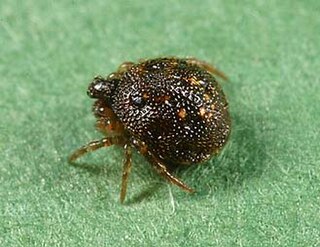
Theridiidae, also known as the tangle-web spiders, cobweb spiders and comb-footed spiders, is a large family of araneomorph spiders first described by Carl Jakob Sundevall in 1833. This diverse, globally distributed family includes over 3,000 species in 124 genera, and is the most common arthropod found in human dwellings throughout the world.

Achaearanea is a genus of comb-footed spiders that was first described by Embrik Strand in 1929.

Theridiosoma is a genus of ray spiders that was first described by Octavius Pickard-Cambridge in 1879. They use their web as a high speed slingshot to actively hunt for prey.

Episinus is a genus of comb-footed spiders that was first described by Pierre André Latreille in 1809.

Argyrodes, also called dewdrop spiders, is a genus of comb-footed spiders that was first described by Eugène Louis Simon in 1864. They occur worldwide, and are best known for their kleptoparasitism. They can spin their own webs, but tend to invade and reside in their hosts' webs. This relationship can be commensal or even mutual if the dewdrop spider feeds on small trapped insects that are not eaten by the host. Some species can even prey upon the host.

Theridion is a genus of tangle-web spiders with a worldwide distribution. Notable species are the Hawaiian happy face spider (T. grallator), named for the iconic symbol on its abdomen, and T. nigroannulatum, one of few spider species that lives in social groups, attacking prey en masse to overwhelm them as a team.

Enoplognatha is a genus of comb-footed spiders that was first described by P. Pavesi in 1880. They have both a large colulus and a subspherical abdomen. Males usually have enlarged chelicerae. It is considered a senior synonym of Symopagia.

Rugathodes is a genus of comb-footed spiders that was first described by Allan Frost Archer in 1950. It is closely related to members of Theridion and Wamba.

Parasteatoda is a genus of comb-footed spiders that was first described by Allan Frost Archer in 1946. The name is a combination of the Ancient Greek "para-" (παρά), meaning "near" or "next to", and the theridiid genus Steatoda. The Japanese name for this genus is O-himegumo zoku.

Platnickina is a genus of comb-footed spiders that was first described by A. Ö. Koçak & M. Kemal in 2008.

Phoroncidia is a genus of comb-footed spiders that was first described by J. O. Westwood in 1835.

Phylloneta is a genus of comb-footed spiders formerly considered a sub-genus of Allotheridion, and raised to genus status in 2008. The type species was first described by Eugen von Keyserling in 1884 as Theridion pictipes. As of September 2019 it contains three species and two subspecies with a holarctic distribution: P. impressa, P. pictipes, P. sisyphia, P. s. foliifera, and P. s. torandae.
Jamaitidion is a monotypic genus of comb-footed spiders containing the single species, Jamaitidion jamaicense. The genus was first described by J. Wunderlich in 1995, and is found on the Greater Antilles. The sole species of this genus was described by Herbert Walter Levi in 1959. It was originally placed in Theridion, but was moved to its own genus based on unique features of the epigynum.

Neospintharus is a genus of comb-footed spiders that was first described by H. Exline in 1950. It was synonymized with Argyrodes in 1962, but revalidated in 2004.

Phycosoma is a genus of comb-footed spiders that was first described by Octavius Pickard-Cambridge in 1880.

Rhomphaea is a genus of comb-footed spiders that was first described by Ludwig Carl Christian Koch in 1872.

Ruborridion is a monotypic genus of Asian comb-footed spiders containing the single species, Ruborridion musivum. The species was first described under the name Theridion musivum in 1873. The genus was described by J. Wunderlich in 2011. They are found in India and in the mediterranean area
Takayus is a genus of Asian comb-footed spiders that was first described by H. Yoshida in 2001.

Yunohamella is a genus of comb-footed spiders that was first described by H. Yoshida in 2007.

















